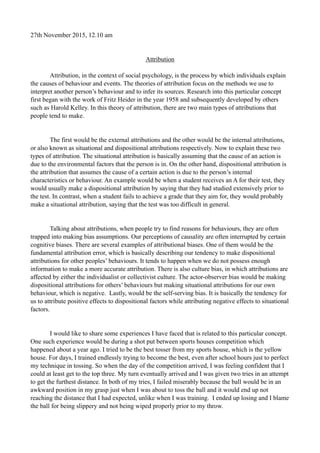
Attribution
- 1. 27th November 2015, 12.10 am Attribution Attribution, in the context of social psychology, is the process by which individuals explain the causes of behaviour and events. The theories of attribution focus on the methods we use to interpret another person’s behaviour and to infer its sources. Research into this particular concept first began with the work of Fritz Heider in the year 1958 and subsequently developed by others such as Harold Kelley. In this theory of attribution, there are two main types of attributions that people tend to make. The first would be the external attributions and the other would be the internal attributions, or also known as situational and dispositional attributions respectively. Now to explain these two types of attribution. The situational attribution is basically assuming that the cause of an action is due to the environmental factors that the person is in. On the other hand, dispositional attribution is the attribution that assumes the cause of a certain action is due to the person’s internal characteristics or behaviour. An example would be when a student receives an A for their test, they would usually make a dispositional attribution by saying that they had studied extensively prior to the test. In contrast, when a student fails to achieve a grade that they aim for, they would probably make a situational attribution, saying that the test was too difficult in general. Talking about attributions, when people try to find reasons for behaviours, they are often trapped into making bias assumptions. Our perceptions of causality are often interrupted by certain cognitive biases. There are several examples of attributional biases. One of them would be the fundamental attribution error, which is basically describing our tendency to make dispositional attributions for other peoples’ behaviours. It tends to happen when we do not possess enough information to make a more accurate attribution. There is also culture bias, in which attributions are affected by either the individualist or collectivist culture. The actor-observer bias would be making dispositional attributions for others’ behaviours but making situational attributions for our own behaviour, which is negative. Lastly, would be the self-serving bias. It is basically the tendency for us to attribute positive effects to dispositional factors while attributing negative effects to situational factors. I would like to share some experiences I have faced that is related to this particular concept. One such experience would be during a shot put between sports houses competition which happened about a year ago. I tried to be the best tosser from my sports house, which is the yellow house. For days, I trained endlessly trying to become the best, even after school hours just to perfect my technique in tossing. So when the day of the competition arrived, I was feeling confident that I could at least get to the top three. My turn eventually arrived and I was given two tries in an attempt to get the furthest distance. In both of my tries, I failed miserably because the ball would be in an awkward position in my grasp just when I was about to toss the ball and it would end up not reaching the distance that I had expected, unlike when I was training. I ended up losing and I blame the ball for being slippery and not being wiped properly prior to my throw.
- 2. Another experience of mine is quite recent, when I was 16 years old. An exam was approaching and everyone was studying for it. I did my studies as well. I felt that I had studied enough for the exams. As we went through our exams, I realised that I could not answer a considerable amount of questions. In the end, I answered those questions in a rather clueless manner At the time, I thought that the exams were generally difficult and I thought I should blame the test itself for being too difficult to answer. I had failed to make a dispositional attribution for my own failure at the time and instead only manage to make a situational attribution by only blaming the test being difficult. As of that moment, I had started to try to make a dispositional attribution for my own failure and try to improve myself from there. As a conclusion, attribution can help in explaining causes of certain behaviours of people and events that occur. It is something that people always do and it can be accurate and can be useful. But in order to do so, the element of bias must get mixed up in order to avoid an inaccurate attribution on a certain event. As bias is already a negative aspect, it would most of the time create an inaccurate attribution due to rejection of some details that contradicts to a person’s belief.